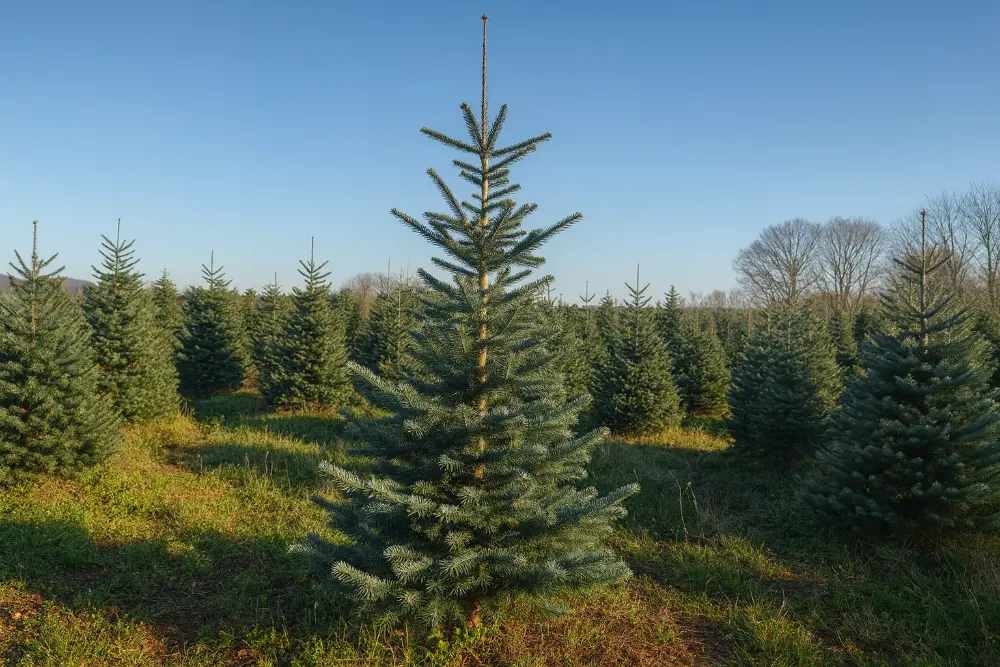Cook Blue Fir Christmas Trees

Is the Cook Blue Fir a Good Christmas Tree?
If you’re trying to choose the best Christmas tree, the Cook Blue Fir — sometimes called “Cook’s Blue Balsam Fir” — is a strong contender. This variety takes the beloved qualities of the balsam fir and adds a touch of blue-green color that makes it stand out in a holiday setting. Families who want a tree that feels both traditional and just a bit different often find themselves drawn to this option.
Pros:
- Distinctive blue-green tint for a unique holiday look
- Strong fragrance reminiscent of the “classic Christmas smell”
- Symmetrical, pyramidal form with sturdy branches for ornaments
- Good needle retention compared to many firs
Cons:
- Slower growth rate than some firs
- Blue color may vary between individual trees
- Can be less widely available than standard balsam firs
The Cook Blue Fir sits in an interesting niche. It has more color personality than a balsam but without straying too far into the silvery tones of a Concolor Fir or the rugged look of a Lodgepole Pine.
Description & Common Characteristics of the Cook Blue Fir
At heart, the Cook Blue Fir (Abies balsamea ‘Cook’s Blue’) is a selection of balsam fir bred for its bluish needle hue. Its needles are flat, short, and soft to the touch, ranging about ⅝″ to 1″ in length. The bluish cast is most noticeable as the tree matures, typically after three years of growth, creating a subtle shimmer under holiday lights.
The overall shape is conical to pyramidal, the kind decorators love for symmetry. Branches are strong enough to hold a wide range of ornaments, from delicate glass to heavier keepsakes. When you brush a branch, it releases a sharp, resinous fragrance — unmistakably “Christmas” in its scent.
In retail settings, you’ll sometimes see the Cook Blue Fir marketed alongside balsam, Fraser, or hybrids. In fact, some farms describe it as a hybrid with Fraser, though most nurseries classify it as a balsam variety. Either way, its unique blue tint and fragrance make it a standout.
Needle Retention & Fragrance
How well does it hold up indoors? Needle retention is good, better than standard balsam in many cases, thanks to slightly sturdier spines. With daily watering, you can expect a Cook Blue Fir to last several weeks indoors without heavy needle loss. Its fragrance is strong and pleasing, filling a home with the evergreen scent many families associate with the holiday season.
Where Do Cook Blue Fir Christmas Trees Grow?
Because it’s a cultivar of balsam fir, Cook Blue Fir thrives in the same kinds of places: cold, moist, and well-drained soils in northern climates. It is widely grown in parts of Canada (especially Québec and the Maritimes) and the northeastern U.S., where balsam fir already dominates the Christmas tree market. Growers choose Cook Blue Fir for its combination of hardiness and decorative appeal.
On farms, transplants are available for growers, but the tree is considered slower-growing than other varieties. Like its balsam parent, it performs best in USDA hardiness zones 3–5.
How Much Does a Cook Blue Fir Christmas Tree Cost?
Pricing for Cook Blue Fir is often similar to balsam fir, though the distinctive blue tint can make it slightly more expensive at certain farms or retail lots. Expect to pay approximately:
- Small (4–5 ft): $45–$75
- Medium (6–7 ft): $75–$120 (most common)
- Large (8–9 ft): $120–$180
Prices fluctuate depending on whether you choose a cut-your-own farm experience or purchase a pre-cut tree at an urban lot. Farms typically offer fresher trees at better value, along with the seasonal tradition of picking your own.
How to Care for a Cook Blue Fir Christmas Tree
Want your Cook Blue Fir to look fresh all season? Follow this care checklist:
- Fresh cut – Saw off ½–1 inch from the base before placing in the stand.
- Water daily – Keep the water level above the base at all times. A Cook Blue Fir can drink a surprising amount in the first week.
- Choose the right location – Keep away from heat vents, fireplaces, or direct sun.
- Support ornaments – Strong branches will hold ornaments, but balance heavier ones across the tree.
- Clean up as needed – Expect minimal shedding if watered well.
With good care, the Cook Blue Fir should last 4–5 weeks indoors.
Where to Find a Cook Blue Fir Christmas Tree Near You
Ready to bring one home? While not as widely available as balsam or Fraser fir, many farms in northern states and Canadian provinces offer Cook Blue Fir. Its unique look and fragrance make it a popular niche choice among holiday shoppers.
Find local farms in our Christmas tree farms directory.